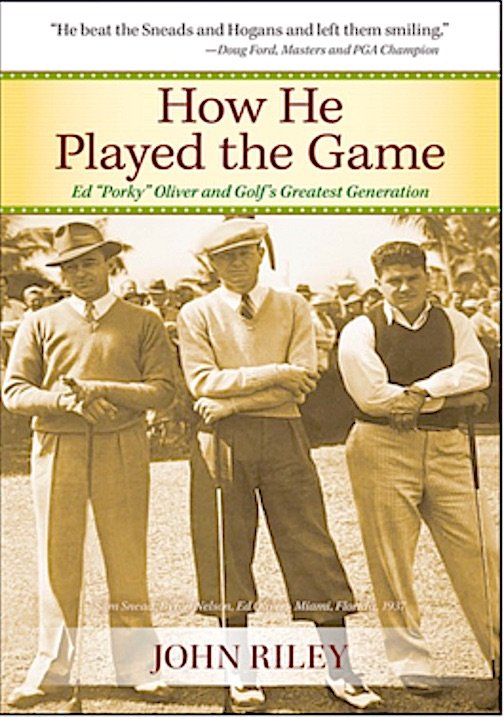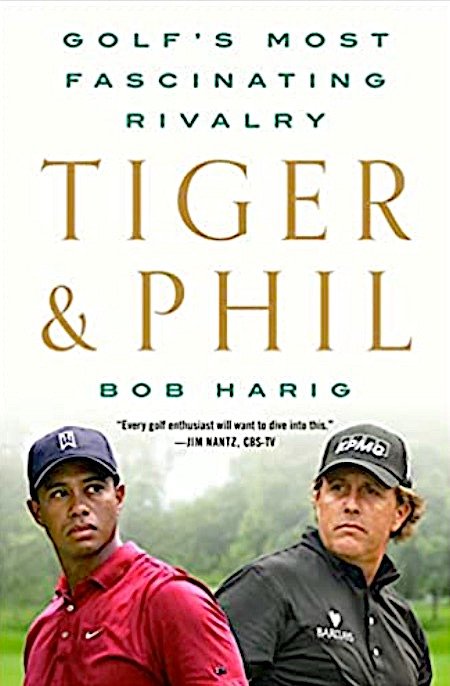New reads on the Tiger-Phil dynamic and a gem of a golf star named Porky
In 40 years as a golf writer, I’ve observed that the decline of golf book publishing has been as bad as anything in the sport. The reader of golf literature has seen the supply line basically dry up. It’s been just the opposite of the steady increase in tournament prize money and wealth for pros. During the many years I reviewed golf books prior to the 2008 recession, the flow of new titles was constant, but the negative effect was some absolutely woeful golf writing of books that should never have been run through the press because publishers of all stature were willing to print anything, mixing in iffy subject matter with great.
But after 2008, there’s been a slow decrease in new golf books as the print world overall has taken a substantial hit that’s still unsettled. A benefit has been better discernment to print quality books but that doesn’t mean the end of poor golf books. That’s due to the increasing popularity in self-publishing, vanity books as some call what’s being printed. That market has become the go-to option to the old book business model, which doesn’t take as many chances on unknown writers and topics anymore no matter how viable they are. But quality in the self-published product in its writing and production has gone up, and writers struggling to get recognition by the major publishers have found a niche in going it alone.
This golf book roundup will focus on a new title in both the traditional and self-published categories, and because I love underdogs the older I get, first up is a biography on Ed (Porky) Oliver by John Riley titled, “How He Played the Game.” Riley is quite qualified to author an Oliver book. As a fellow Delawarean, a member of the Golf Heritage Society and with an historian’s eye for his subject, Riley is about the most able person on the planet to profile Oliver.
Oliver was a notch below the elite players during the great reign of Snead, Hogan, and Nelson in the late 1930s through 1950s, but the man from Wilmington was often on the cusp of doing something special, as seen by runner-up finishes in the 1946 PGA, 1952 U.S. Open and 1953 Masters. His derisive nickname would not have fit in today’s acceptable lexicon but in Oliver’s prime years he was more husky than portly. At 5-foot-9, 240 pounds, Oliver’s body build compared with Lou Costello of Abbott and Costello and he had a similar affable personality that was well liked by fans and fellow players. Oliver was once called the “most popular player on the circuit.”
As one of the classic personalities in tour history, Oliver not only made his mark for his camaraderie but his game earned respect, too, with eight PGA Tour victories and three Ryder Cup appearances. His record would have been more substantial had he not served the U.S. for four and a half years in the Army in World War II.
Growing up in Wilmington, Riley knew the Oliver family and has memories of seeing Ed suffer through cancer at the end of his life; he died in 1961. Riley, retired from a public affairs career, had input from Oliver’s surviving children and did great homework elsewhere. The book has the extensive research and anecdotal history that deserves a major publisher treatment, but Oliver is not a mainstream golfer and that matters in traditional publishing today. Riley went the self-publishing route and utilized the design work of Mike Fontecchio of Faith and Family Publications. The resulting 378-page book looks more than acceptable on the bookshelf and the content is packed with not only Oliver’s career details but it gives a wonderful in-depth view of the tour as the real pioneers of today’s circuit lived it. As each year takes us further away from the pre-Palmer years when the PGA Tour was trying to shape itself into a premier sport, it is doubtful that many of today’s tour players have any appreciation for the players who labored year after year to make it work. This book will help anyone come to appreciate them as life on the tour is retold in tracing how Oliver’s career played out alongside his fellow tourists. More than 60 years after his passing, it’s refreshing to see Ed Oliver have his name in a book that gives him his due besides being known for an oddball nickname.
It is disappointing that a book of this quality on a unique tour character has to struggle for attention. We should be seeing subjects like Oliver profiled more often. He was someone who spanned eras of the great players, from Sarazen to Palmer and Nicklaus. Oliver had a great relationship with countless players, including Arnie, who considered Porky one of his favorites in his early tour life.
Riley has diligently sought feedback and endorsements about his book and recently got this compliment from all-time amateur great Jay Sigel who told Riley, “I didn’t want this book to ever end.” To order, go to olivergolfbook.com for versions in eBook ($20), paperback ($25) and hardback ($30), or to amazon.com.
Sure to be a hit with today’s more youthful-leaning golf fans just for their name recognition alone is the traditionally published “Tiger & Phil,” written by Bob Harig, a golf writer who has covered Tiger Woods and Phil Mickelson since their careers began through outlets such as ESPN.com and now with Sports Illustrated. Published through St. Martin’s Press, “Tiger & Phil” was taken to completion in the capable hands of Susan Canavan of the Waxman Literary Agency, who had done the same thing with Ian O’Connor’s “Arnie & Jack” in 2008.
Subtitled “Golf’s Most Fascinating Rivalry,” the Tiger/Phil book won’t be short of intrigue. Depending on your point of view, Woods is either the greatest golfer ever or a spot behind Jack Nicklaus or any of your other favorite options. He had the world, even beyond golf, in his hands through November 2009, his fans overlooking his many personal quirks and on-course temper, but then infidelity hit his image hard as did many injuries. He’s presently trying to get his health in stable form after a devastating car accident this time last year when he could have lost his life but then saving his right leg became critical.
Mickelson, the older of the two by five years, came on tour before Woods and was proclaimed the next great player, but he never fulfilled that prediction and by the time Woods came on tour in late 1996 it was too late. Woods was dominant from the moment he joined the tour and Phil couldn’t break through at a major until 2004, roughly seven years after Woods turned pro.
There was never any question that Woods was the better golfer. Phil had to settle into several subordinate roles: “the Thrill” for his daring (and sometimes careless) strategy on course, short-game expert, mimicker of Arnie to please the fans. The latter was to contrast the stoic, guarded, private, arm’s length Tiger so Phil would be the people’s favorite and underdog. While Woods kept knocking off major victories, Mickelson constantly garnered attention for something unusual, such as his two-driver strategy used on occasion. After he became a major champion, Mickelson showed a cockier side to his relationship with Woods, tweaking Tiger’s nose that he used inferior equipment, plus many other jabs. And Phil also would go down many strange avenues, such as the recent one in which he got into hot water over controversial comments about the PGA Tour and those in charge of a Saudi Arabia-backed “rogue” global tour. He trashed the PGA Tour and got hammered for it, prominently by Rory McIlroy among many.
So Harig’s book is well-timed on many levels. He traces all the idiosyncrasies of each man’s career, from their Southern California roots to golf stardom, including elements of their careers not necessarily tied to each other. One such instance is Mickelson’s trashing of Captain Tom Watson in the U.S. team’s loss in the 2014 Ryder Cup, which he did instead of blaming the players for not performing better, a critique Patrick Reed correctly chose.
Arnie and Jack continue to be golf’s all-time greatest mano-a-mano duo for the simple reason it was the game’s all-time most important player and the game’s all-time greatest player. Each showed a public competitive dislike for the other but they also worked together at times for the good of the game’s growth in all aspects and on many occasions teamed up on course to whip the competition. Woods and Mickelson notably failed as a pairing on course and their personalities were so opposite that it was difficult seeing Woods getting past the common perception of Mickelson that his actions were just “Phil being Phil.” It was hard to take him seriously at times. The main thing Arnie/Jack and Tiger/Phil have in common is that as they reached middle age they could more publicly appreciate the other and find it within their heart to give the other credit for what they’d achieved.
There are few tour beat writers today who could have tackled the complicated Woods/Mickelson intrigue any better than Bob Harig. He mixes in each superstar’s warts and bruises with their shining moments with equal weight and puts them together in a chronological mix that helps the reader understand their relationship in a clearer perspective.
There is an entire national publicity campaign for “Tiger & Phil” to back the 336-page book’s April 26 on-sale release ($29.99). For ordering visit your usual purchase sources, such as amazon.com.
Other books in the last year this reviewer would recommend include:
By Tom Coyne, “A Course Called America: Fifty States, Five Thousand Fairways, and the Search for the Great American Golf Course” (Avid Reader Press, 416 pages, $24.49)
By Ed Gruver, “Bringing the Monster to Its Knees” (Lyons Press, 256 pages, $29.95).
By Tony Jacklin, “Tony Jacklin: My Ryder Cup Journey” (Pegasus, 225 pages, $12.99).
By Peter May, “The Open Question, Ben Hogan and Golf’s Most Enduring Controversy” (Rowman & Littlefield, 224 pages, $24.95).
By Jack Nicklaus II and Don Yaeger, “Best Seat in the House: 18 Golden Lessons from a Father to His Son” (Thomas Nelson, 224 pages, $14).
By Dr. Bob Rotella, with Roger Schiffman, “Make Your Next Shot Your Best Shot,” (Simon & Schuster, 233 pages, $27).
By Steve Scott, “Hey, Tiger, You Need to Move Your Mark Back” (Skyhorse, 256 pages $17.99).
By Sports Illustrated, “Sports Illustrated Tiger Woods: Celebrating 25 Years on the PGA Tour” (Sports Illustrated, 232 pages, $15).
By Michael J. Stott, “Too Much Loft” (BookBaby, 500 pages, $24.99).
By PGA Master Professional Stephen A. Vigiano, “Enrich Your Life and the World with the Game of Golf” (Outskirts Press, 184 pages, $10.18).
By Bubba Watson, with Don Yaeger, “Up and Down: Victories and Struggles in the Course of Life” (Thomas Nelson, 240 pages, $19.59).
By Philip Young, “Bethpage State Park and the Three Geniuses Who Created It” (Golden Age Research, LLC, $45).


